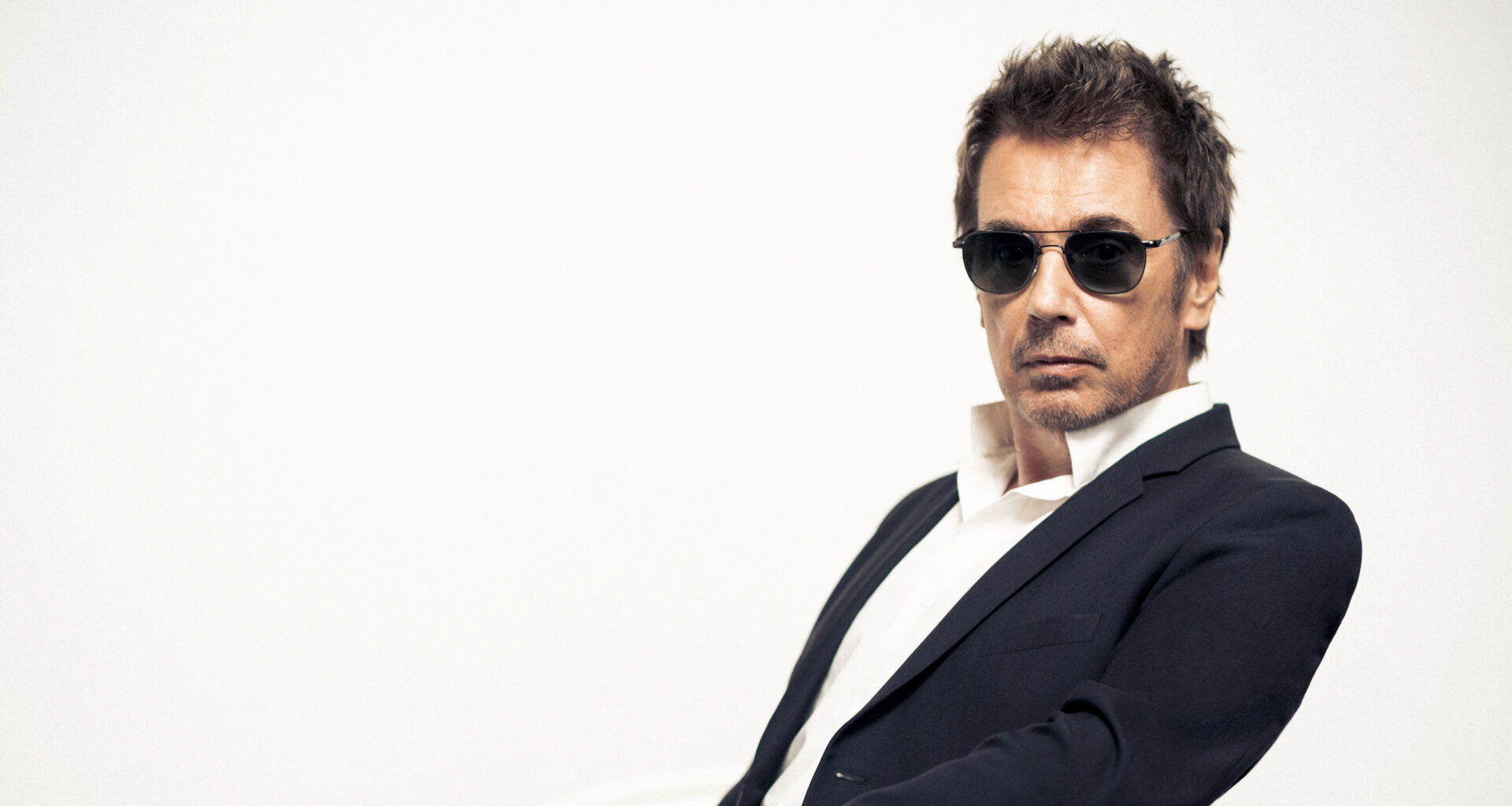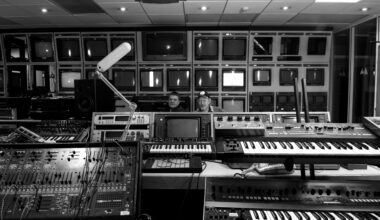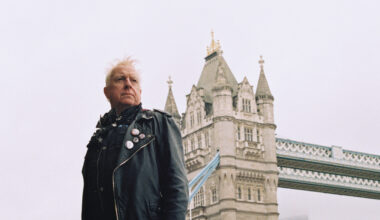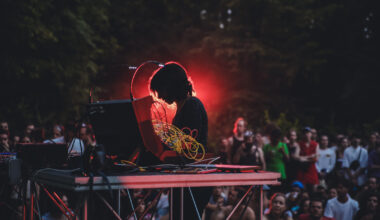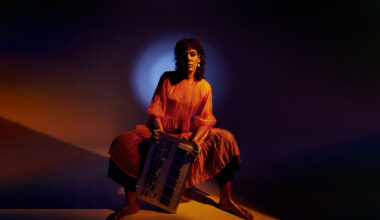Jean-Michel Jarre is forever looking to move inexorably forward. His latest album, ‘Oxymore’, is a musique concrète record created with 21st century technology, pushing 3D binaural sound to incredible new levels and keeping the French maestro several steps ahead of the curve. Headphones on…
There are early adopters… and then there’s Jean-Michel Jarre. The French electronic pioneer has enjoyed an unparalleled career spanning nearly half a century, always at the cutting edge of technology and with each release anticipating in some way what was to come – from groundbreaking synthesisers and laser harps to leaps forward in studio production and the consumption of the music itself.
And so it is that, on a sunny late autumn afternoon in north London, a small group of music journalists and up-and-coming composers have been invited to listen to ‘Oxymore’, Jarre’s 22nd studio album, at the premises of L-Acoustics, the French manufacturer of amplifiers and loudspeakers. While the album can obviously be listened to on a simple hi-fi system or through headphones, the sheer fantasia of the immersive event we’re treated to is really quite something.
Artists as diverse as Brian Eno, Tears For Fears, Lady Gaga and Snarky Puppy have recently embraced Dolby Atmos, the universal format for multichannel, home cinema and spatial audio launched by Dolby Laboratories a decade ago. Jarre is one step ahead of the game as usual, though, with his new album available as both a Dolby Atmos and a binaural mix.
Binaural sound, an immersive audio headphone experience, might give you some idea of the revolution that beckons, but nothing prepares you for the 360-degree thrill of ‘Oxymore’, with spatial sound penetrating your receptors in unison.
White speakers have been assembled in a circle around the audience at the playback, positioned like the hours of a clock face. You can hear water gently trickling down the walls on one side of the room as the opening track of the album, ‘Agora’, begins to play, contrasting with the crackling of a fire on the other side.
Jungle noises pop out of ‘Crystal Garden’, whorls of mechanical clicks and whirrs underpin ‘Brutalism’, and a bird flaps ominously by on ‘Animal Genesis’. It’s not quite the Lumière brothers projecting moving images to dumbfounded spectators in fin-de-siècle Paris, but it’s up there.
Jarre wanders about the room unobtrusively as the album plays, tapping the brickwork and taking in how the different elements reverberate off the walls and the ceiling.
“The goal of all of this is actually to share with people the feeling of being inside the music,” he says, speaking to the audience afterwards.
The transition from stereo to spatial could prove to be as seismic as the switch from mono to stereo was in the late 1960s. There have been false dawns before, of course, and this may be another. But Jarre believes our tilt towards the virtual world in order to communicate with each other during the pandemic has quickened our collective acceptance of concepts such as the metaverse. And if we’re opening up to the idea of virtual reality, it stands to reason that sound enhancement will soon follow.
Jean-Michel Jarre is occupied with his phone when I hook up with him at the Sony Music offices the following day. Having been in a meeting for several hours, he’s digesting his missed messages as he paces up and down. You’d imagine a man like Jarre would have been wired into the matrix already, such is his oneness with technology, but he appears to still need to answer texts like the rest of us. He asks someone to fetch him an espresso and promises to give me his full attention when he’s finished with his messages.
Jarre is true to his word and, with the interview underway, he is a thoughtful and attentive subject. Expressions such as “That’s a good question” and “It’s true what you say” pepper his conversation. A recent recipient of the Légion d’Honneur in France, he’s very friendly and one of his interview tactics seems to be to make you think you’ve thought of everything. As well as being effortlessly charming, he looks as freakishly youthful as ever. Few 74-year-olds could carry off wearing a snakeskin jacket and sunglasses indoors, but Jarre’s certainly one of them.
The French synthesist might be here to promote his new album, but he’s an evangelist for something more radical in the long term – and his proselytising is working.
“I’m absolutely convinced that immersive sound is the next revolution, just like the emergence of synthesisers before it,” he announces.
Ahead of getting into the nitty-gritty of ‘Oxymore’, I wonder why Jarre thinks spatial sound is the next frontier when other formats have failed to live up to initial expectations. He was similarly enthusiastic about Dolby 5.1 surround sound when he released his ‘AERO’ album in 2004. Aside from its adoption in cinemas, it fell significantly short of becoming the next big thing.
“That’s a very interesting question,” he says, pondering for a moment. “Because at the beginning, 5.1 was really amazing.”
He talks about how he jumped on the technology – as did artists like Pink Floyd – but concedes that what they did then might seem somewhat gimmicky compared with the latest sonic possibilities.
“Firstly, there is a platform for this, which there wasn’t with 5.1,” he continues. “Sure, 5.1 was taken up in the movie theatres, but most people didn’t have the equipment, so there was no market for it. You already have the tools for binaural right now, though, because it can be used with your smartphone and a set of standard headphones. You can have a totally immersive experience surrounded by music sitting on the Tube. We also didn’t have the polyphony with 5.1 that we do with this.”
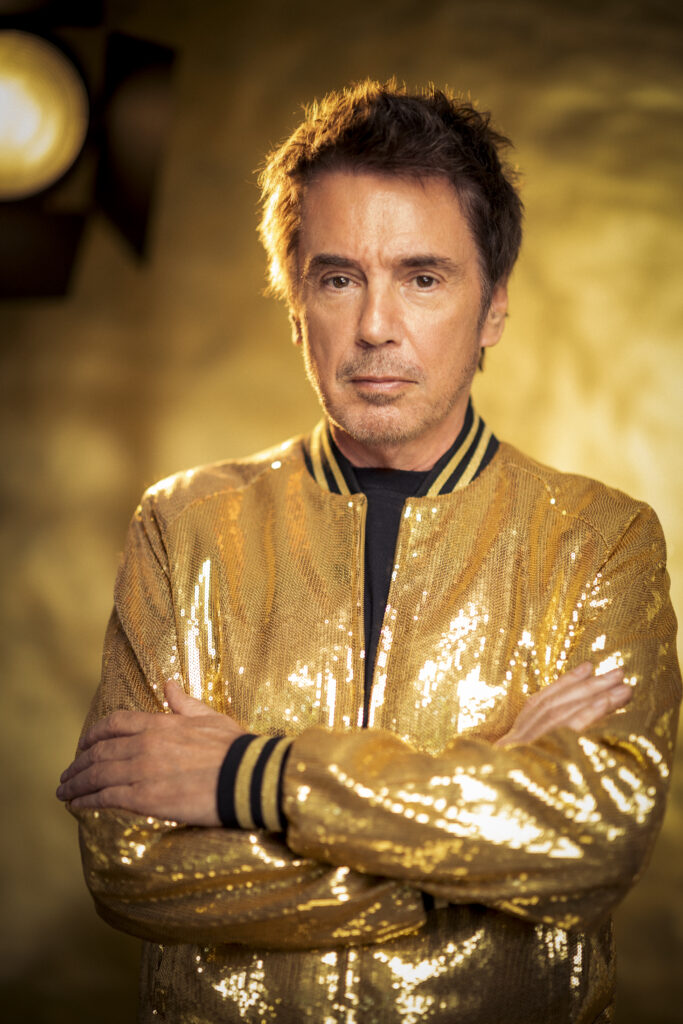
Jarre goes on to speak about the Doppler effect, where a frequency changes as the source alters position relative to the listener. With the new spatial sound system, this simulation of details moving around you – running water, a flapping bird, or whatever – becomes seamless.
“Suddenly, the fact that you don’t have to deal with stereo anymore means I could put this here… and then I could move it there,” says Jarre, gesturing with his hand. “And it’s not just for fun, because it actually creates emotions. This is the reason I think it’s going to change how music is produced in the future. Especially electronic music.”
‘Oxymore’ is a record that looks back and yet is rarely nostalgic. It relates to a series of formative events in Jarre’s life, all of them interconnected by threads of time.
“I remember Fellini told me one day, ‘Whatever you do, you always make the same film or the same music’,” says Jarre, speaking about Federico Fellini, the great Italian auteur and one of his heroes. “It’s the inclination of who you are and your own obsessions.”
Jarre eschews melody for texture on ‘Oxymore’, a kind of scorched-earth policy that pays off handsomely. The album marks a return to where everything started for him – at the Groupe de Recherches Musicales (GRM), the electroacoustic music laboratory in Paris where he studied under the tutelage of musique concrète legend Pierre Schaeffer in the late 1960s. There are even echoes of his 1971 debut release, a seven-inch bringing together ‘La Cage’ and ‘Erosmachine’, two tracks he had recorded at the GRM a couple of years earlier.
“The origin of electronic music is based on textures,” says Jarre. “This whole project is a tribute to the electroacoustic pioneers and especially to the French way of approaching this music. These guys were obsessed with texture and how sound could evolve with the Doppler effect of something like a car or a train passing by. So I wanted to go back to this approach, to this method, and at the same time explore what immersive sounds enable you to do, because every element of the album has been given the space in which it can be fully expressed and heard.”
By imposing quite strict ways of working on himself, Jarre has opened up different sonic worlds to play around in and crafted one of his most relevant albums since the 1980s. In fact, it’s arguably one of his best overall. As ever, he has his eyes on the prize – and that shiny and often elusive object is almost always the future.
“Working on the evolution of textures is why ‘Oxymore’ is a very special album for me in my career,” he asserts. “Because I do think I’ve made a link between the origin of electroacoustic music – because I studied it, this was also my origin – and 21st century technology.”
Perhaps surprisingly, one album that doesn’t correlate with ‘Oxymore’ is ‘Oxygène’, Jarre’s stunning breakthrough release. He recorded the 1976 classic in his kitchen studio with an ARP 2600, an EMS VCS 3, a Mellotron and a 4-track Revox, as well as a Korg Mini-Pops 7 drum machine for those unmistakable bossa nova riddims, his initial concept arising from a desire to tread a line between avant-garde music and pop. It proved to be an astute hunch. ‘Oxygène’ has sold in excess of 18 million copies worldwide.
“I never even thought about ‘Oxygène’ until the late stage of this album,” he says. “It really hadn’t occurred to me. Of course, I realised afterwards, because some people said, ‘Yes, it’s like more oxygen…’.”
The title ‘Oxymore’ comes from the word “oxymoron”, which the Oxford English Dictionary defines as “a figure of speech in which apparently contradictory terms appear in conjunction”. This was an idea at the very heart of the Groupe de Recherches Musicales and the modus operandi of Pierre Schaeffer. So what was Schaeffer like?
“You know, he was quite a strange person and a real genius too,” replies Jarre, with deep admiration. “He saw everything. He saw the music of the future, he saw the internet, he saw the future of communications, and he wrote lots of very complex but very clever books about the future of broadcasting, which you should read if you have the courage.”
The GRM wasn’t the happiest of places for Jarre, however. He found the focus too dry, too earnest, too obviously academic. It was sometimes almost prescriptively anti-emotional.
“I left the GRM because I didn’t like the arrogance of their intellectual approach to music, which totally ignored what was going on in pop culture,” reveals Jarre. “Bands like Pink Floyd and Soft Machine were also using textures and experimenting in ways that were close to what was happening at the GRM, but the GRM people didn’t want to know about them. They thought they were the only ones in the world doing this.”
When Jarre told Schaeffer he wasn’t interested in staying in a laboratory for the rest of his life, the GRM head encouraged his protege to follow his instincts.
“Schaeffer said to me, ‘Yes, you shouldn’t waste your time here’,” he recalls. “He said, ‘Your destiny is out of this place, to experiment more with an audience in mind, and to follow your own way’.”
Schaeffer’s musique concrète comrade-in-arms was another Pierre, Pierre Henry, who helped him set up the French radio-aligned Groupe de Recherche de Musique Concrète (GRMC) in 1951. Before that, they had been involved in Schaeffer’s radiophony-oriented Studio d’Essai, where they even worked with perfunctory turntables.
“That’s why I call these guys the first DJs,” notes Jarre. “A lot of people think electronic music is a recent thing, but this whole movement goes back a long way. What Schaeffer and Henry did in the 1940s and 1950s started everything off. The fact is they were the first to think of music not in terms related to solfeggio, but in terms of noise.”
While Schaeffer continued in academia for many years, becoming an associate professor at the Conservatoire de Paris in the latter part of his career, Henry journeyed out into the wider world and turned his attention to composing. One or two of his pieces found a place in pop culture, but his success was somewhat limited.
“Not too many people really know about Pierre Henry… and I think that’s unfair,” says Jarre. “If he’d been American, he would probably be as well-known as John Cage, if not more so. The tragic aspect of Henry is he’s mainly recognised for the one song, ‘Psyché Rock’, which was remixed by Fatboy Slim, but that was actually co-written by a famous soundtrack composer called Michel Colombier, who did a lot of the arrangements for Serge Gainsbourg.”
Pierre Henry was one of the artists Jarre had intended to work with on the first of his collaborative ‘Electronica’ albums in 2015, but Henry’s failing health prevented his participation. And although he sadly died two years later, he inadvertently provided the impetus for ‘Oxymore’ when he bequeathed Jarre a number of stems containing some of the concrète material he had amassed.
Henry receives a posthumous co-writer credit on most of the tracks on the album, despite only being involved in spirit. He can also be heard talking about the processes of his work on a couple of the pieces, including ‘Agora’. His found sounds permeate the record and Jarre acknowledges that they were an impetus for the project, the subtitle of which is ‘Homage To Pierre Henry’.
“At the end of the day, I used perhaps five per cent of the sounds here from Pierre Henry,” he says. “So it was not that much, but he was very important as a source of inspiration.”
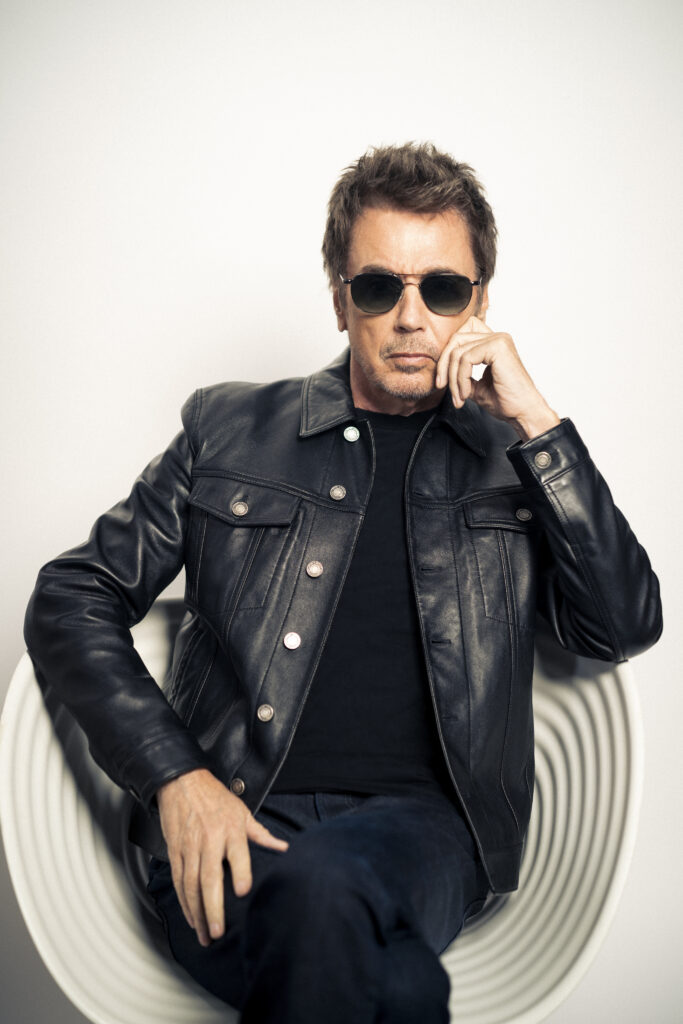
Ultimately, the album is a tribute to both Pierres, the rocks upon which electronic music was built, using the most cutting-edge equipment available.
“That is another reason why it’s called ‘Oxymore’,” affirms Jarre. “Because ‘Oxymore’ is the basis of electronic sound sampling. You take a sample of the rain and mix it with a clarinet. Or you take a sample of an engine and mix it with an electric guitar. When you do that, you create these monsters – morphed creatures and sonic androids.”
Jarre employed a fascinating array of instruments to conjour up his “monsters”. Alongside his trusty Mellotron, the sleeve notes of the album mention two brand-new synths, an Osmose from the French manufacturer Expressive E and a C15 from Nonlinear Labs in Germany, as well as a Blipbox, a Wuhan Wind Gong and a Cristal Baschet, which is a sculptural instrument that acts as a metallic resonator. He also made his own organic sounds from scratch.
“To simulate fire, for instance, I used some magnetic tape,” he explains. “But I was touching and twisting and crunching it in front of a mic. I really explored lots of different techniques to produce these kinds of things.”
As a result, ‘Oxymore’ is less a collection of compositions, more an artful collage of sound design.
“And sound design is one of the core elements of modern composition these days,” asserts Jarre. “That’s why I thought that linking my work with somebody like Pierre Henry, and showing how I was inspired by him, would be a nice move.”
If that was the starting point, then the album was to become something else entirely once it got underway. The addition of disparate components makes it a musique concrète record with a distinctly 21st century sensibility. It’s quite unlike anything else you’ll have heard before.
“Essentially, what I’ve tried to do all along is keep this kind of organic, sensual, sexual aspect. So on ‘Brutalism’, we had direct contact with a maelstrom of noises – not just industrial noises but also an avalanche. So it’s something that is very organic… but also dangerous.”
Jean-Michel Jarre was one of the most recognisable faces on the planet during the 1970s and 1980s, playing parts of the world that other artists couldn’t reach. In 1981, he became the first Western musician to perform in China after the Cultural Revolution, resulting in his hugely successful ‘Les Concerts En Chine’ double live album. He is reputed to have played to more people in one evening than any other artist, in front of three-and-a-half million Muscovites in 1997 (having previously achieved record-breaking crowds at city spectaculars in Paris and Houston).
Jarre’s influence on electronic music has been profound and unquantifiable. His many accomplishments are known to people who profess to having no interest in music at all, whether electronic or otherwise. He remains a household name getting on for five decades after breaking down so many barriers with ‘Oxygène’ and its 1978 follow-up, the equally brilliant ‘Équinoxe’. That’s some feat for a pop icon who doesn’t sing.
Looking further back at the influences and epiphanies that got Jarre to where he was going is a boulevard less travelled. His experiences as a younger man have undoubtedly informed his latest release, though. With ‘Oxymore’, the present is the past and vice versa.
Jean-Michel André Jarre was born in the 4th arrondissement of Lyon in 1948. His mother, Francette Pejot, had been a notable member of the French Resistance during the Second World War. Arrested by the Nazis in June 1944, she survived almost a year in a concentration camp and passed away in 2010 at the grand age of 96. His father was the composer Maurice Jarre, who was responsible for the film scores to ‘Doctor Zhivago’, ‘Lawrence Of Arabia’, ‘Jesus Of Nazareth’ and ‘Fatal Attraction’, among countless others.
Dubbed the “Capital of the Resistance” by Charles de Gaulle, Lyon now has a street named after his mother, Passage France Pejot, in honour of her remarkable bravery.
“It is maybe a bit strange that, between my mum, my dad and myself, the one who gets the recognition of the street name is my mum,” says Jarre, beaming with pride. “As well as being a major figure in the French Resistance, she also had a strong influence on me in the way that she considered life. She was an extraordinary person.”
Jarre is more ambivalent when speaking about his father, who left for Hollywood when his son was just five years old, separating from Francette in the process. Unsurprisingly, the young Jarre grew up in a house filled with music and visited by a procession of performers and composers, many of them connected to his father. John Cage dropped by while Francette was pregnant, put his hand on her bump and declared, “There is a musician in there!”.
Cage was correct, although he was hardly hedging his bets. Jarre Senior knew the American composer through one of his other great modernist friends, Pierre Boulez, who was as fierce and forthright in person as his public image suggested.
“My father and Boulez were very close,” says Jarre. “They had both been musicians at the Compagnie Renaud-Barrault, the famous Paris theatre troupe, after the war. Boulez was at the piano and my father was a percussionist. Before my father left my mum and me – so this must have been when I was about three or four years old – I have this memory of him and Boulez painting the kitchen in the small apartment where we lived, in the suburbs in the south of France. And Boulez said, ‘Apart from Bach and myself, everyone else is shit’. So, yes, he was a little arrogant perhaps.”
Painting of another kind was actually Jarre’s first love. He initially struggled to decide between trying to make a career in music or art, but he feels he managed to combine the two in the end, creating textural soundscapes in the image of abstract artists like Pierre Soulages, who used mainly black paint applied in thick layers, a technique that he called “Outrenoir” (“Beyond Black”). Soulages died just a few weeks ago aged 102, having worked right up until the end of his life.
“He had these huge, huge canvases,” notes Jarre. “He is a model for all of us, because I consider what he did in these past 15 years to probably be his best work.”
In 1957, on his ninth birthday, Jarre’s mother took him to Le Chat Qui Pêche in Paris, an influential jazz club run by Mimi Ricard, another celebrated French Resistance fighter. Chet Baker, the American trumpeter, was performing that night.
“There is a direct link between this story and ‘Oxymore’,” says Jarre. “I believe this was my first physical experience of music, of the effect of sound on my body. For my birthday, Chet Baker sat me on an upright piano and played his trumpet for me, the instrument being like this…”
He pauses and indicates the bell of the trumpet up close to his thorax.
“Each time I remember this moment, I still think of the effect of the air from the instrument on my chest – the physiological aspect and the effect upon my body. I think it’s something that has probably been quite, quite important in my relationship with sound.”
With his father settled in America, where he remained for the rest of his life, Jarre’s paternal grandfather had stepped into the breach. The young boy would watch transfixed while André Jarre made all manner of amazing devices and machines in his workshop.
“He was an interesting character,” notes Jarre. “He was an engineer and an inventor. A musician too. He made one of the first mixing desks, which was used by a radio station in Lyon before the war. He also created an ancestor of the iPod, an early portable turntable called the Teppaz.
“For my 11th birthday, my grandfather gave me a second-hand tape recorder. It was German, a Grundig, and I was so impressed with this machine. I became totally obsessed with recording everything that I could. My grandmother said to me, ‘Wow, why are you spending all of your days with this thing?’. I would go out and record the noises of the street, the conversations I heard, whatever was happening around me. And then one day, I played the tape backwards… and I suddenly thought that aliens were talking to me. I had discovered sound processing by accident.”
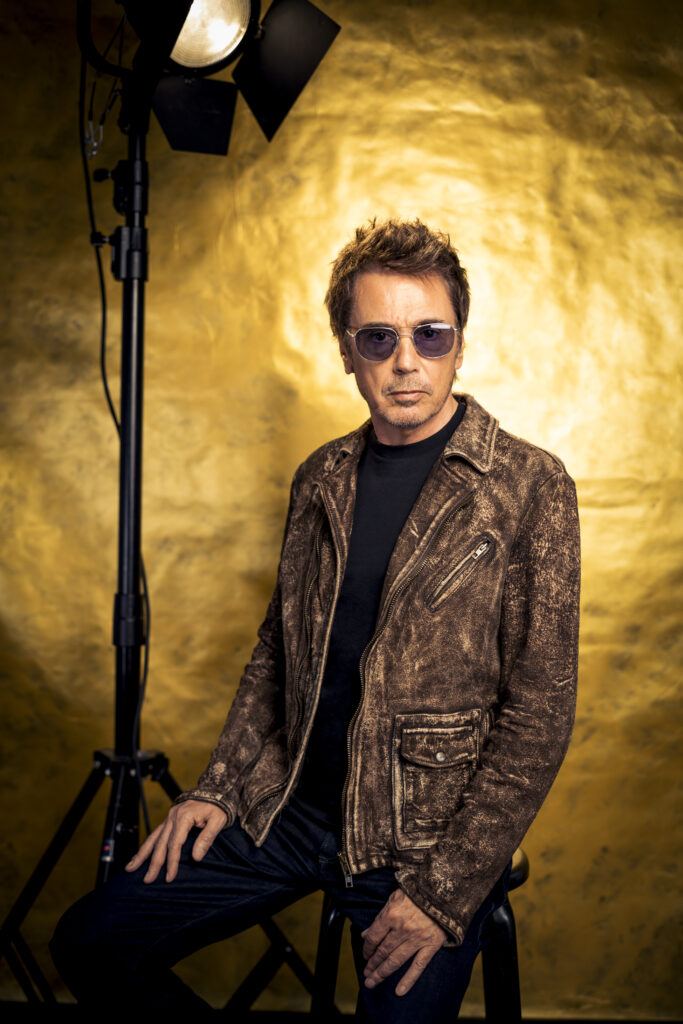
Jarre made use of the tape recorder in the two groups he joined during his teens, Mystère IV and The Dustbins. He played guitar in both outfits.
“I was processing the guitars, the organs, and everything else into this machine,” he explains. “So that first gave me the concept of what would become my job. I suppose this might seem like a cliche, but life is all made out of luck and chance and coincidences. By luck, by chance, my grandfather gave me this tape recorder… and it changed my life.”
At the time that Jarre was recording people on the street, France was involved in the Algerian War of Independence. I wonder if any of this activity had some bearing on his 1988 album, ‘Revolutions’.
“Yes, I think perhaps it did, although I’d say my mum probably influenced me much more,” he reasons.
“Because she was obviously connected with the idea of resistance, which is itself associated with the French notion of revolution. Revolution seems to be always happening somewhere. And don’t forget that people in France are known across the world for wanting to block the country every two weeks on the roads or at the ports or whatever.”
Another big moment in Jarre’s musical education was seeing The Beatles perform at L’Olympia in Paris in 1964. It was during the Fab Four’s run of 18 dates in the French capital at the start of the year. The experience left the 15-year-old speechless, but he also had an important epiphany. Rock ’n’ roll, he decided, was for “les Anglo-Saxons”. He needed to try to find a different path – a path that would lead him to the GRM a few years later.
Jarre’s first synthesiser was an EMS VCS 3. As the 1960s drew to a close, he sold his guitar and amp – “A statement!” – and went to London, to Putney, in order to purchase one of the famous early synths directly from Peter Zinovieff himself. He remembers the scene well.
“It was a small house and such a crazy moment,” he says with a laugh. “It was this very hippy atmosphere. Peter and his wife were in the middle of the living room, with VCS 3s and lots of electronic parts lying about, and then there were two boys who were playing with darts around the house. These were real metal darts. It was fucking dangerous! And nobody cared because it was all, you know, peace and love.”
The VCS 3 played a leading role in Jarre’s contribution to ‘AOR’, a ballet score which he and fellow GRM student Igor Wakhévitch were invited to write for the Opéra de Paris in 1971. They were among the youngest artists to ever compose for the Opéra and ‘AOR’ was the first electronic piece to be performed at the Palais Garnier. Jarre spent much of his time waiting in the wings, however, expecting to be arrested at any moment because of a mix-up about whether or not he should be doing national service.
The same year as ‘AOR’, Jarre happened across a radical theatre production in Paris by the American director Robert Wilson. ‘Deafman Glance’, known as ‘Le Regard Du Sourd’ in French, was an eight-hour silent epic written as a tribute to Raymond Andrews, a deaf-mute boy Wilson had adopted as his son. Unfortunately, we have to rely on the testimony of those who saw it to explain what this avant-garde spectacle was all about.
“I went there by chance,” says Jarre. “It’s a pity it wasn’t filmed because it was a masterpiece. For me, it was something absolutely new. There was no dialogue and it was only later on that I realised Bob Wilson was autistic. The whole concept was about sound, but like a silent movie. It was something very difficult to define because it was like a moving painting, with this extraordinary control of the stage lighting. It has been a major influence on me for stage design.”
But it wasn’t just the lighting of ‘Deafman Glance’ that had a profound effect on Jarre. He was also impressed by the fact that Wilson was able to communicate complex ideas without words.
“I said, ‘This is what I want to do’,” he continues. “I wanted to use instrumental music to try to create a relationship with the audience that went beyond words. I became convinced I could do that with live performances as well, with lights and theatrical techniques, then later on with videos and lasers.”
Following on from ‘AOR’, Jarre composed music for a range of theatre shows, television programmes and advertising jingles, as well as the soundtrack to a 1973 movie called ‘Les Granges Brûlées’ (‘The Burned Barns’). He also worked as a lyricist, which was somewhat ironic given how the silence of ‘Deafman Glance’ had inspired him. After helping to revive the career of French chansonnier Christophe, he was hired to write for Swiss singer Patrick Juvet, with Juvet’s record label paying for the best session musicians money could buy.
“That gave me lots of experience in terms of production in studios,” says Jarre.
Another of his compositions was ‘Que Vas-Tu Faire?’, which he gifted to Françoise Hardy. Serge Gainsbourg, yé-yé’s own tour de force, responded by sending him a bottle of champagne with a note saying, “Welcome to the club”.
Jarre had other ideas, however. Around the time he penned ‘Que Vas-Tu Faire?’, he used some of his songwriting royalties to buy an ARP 2600. The synth proved to be one of the catalysts for ‘Oxygène’, taking a lead role on the album and becoming his trademark sound. He acknowledges that he was late in embracing the Moog – uncharacteristically so – partly because the Minimoog was so expensive in Europe when it first arrived on the market.
“I was definitely an ARP guy at the beginning of my career,” admits Jarre. “There’s no question that the ARP 2600 made a massive contribution to my work in those early days. The Moog came later for me, but the first modular was fantastic and I really liked the Memorymoog too. They have this very spongy sound, whereas I think the ARP is much more precise and much more edgy in terms of attack. But they do complement each other. One instrument I find very interesting at the moment is the Animoog on the iPad. I think that’s great.”
Jarre also singles out the Yamaha CS-60, which he used on ‘Équinoxe’, and the Elka Synthex, which he used on ‘Rendez-Vous’, as important pieces of machinery for him over the years. Right now, though, he’s all about Expressive E’s Osmose. If I’d let him, I suspect he would have spent half the interview raving about the synth’s sensitivity and intuitiveness.
The partnership between sound and vision has been a defining feature of Jean-Michel Jarre’s live performances since the late 1970s. And while Robert Wilson provided his initial inspiration, his visuals have also been heavily influenced by the work of Iannis Xenakis, who was one of his lecturers at the Groupe de Recherches Musicales.
Xenakis was among the most stubbornly academic GRM thinkers when it came to music, but the Greek composer’s audio-visual pieces had a lasting impact on Jarre. Particularly his astounding ‘Polytope’ installations, which featured complex light shows in stunning locations around the world and took place between 1967 and 1984.
“It’s funny that you mention him,” says Jarre. “I met with the Xenakis family, who were celebrating the 100th anniversary of his birth this year, and they recreated one of his ‘Polytope’ pieces. Xenakis was making really brutal music and mixing it with great visuals, even back in the 1950s. He did one of the first light shows with lots of lasers, perhaps the very first, and his pieces were always fantastic. Some people don’t know about him, but he is an important figure for electronic musicians. He was another textures guy.”
The grand-scale outdoor performances often associated with Jarre seem to be at odds with where he’s at now, but his live shows have always been more than just spectacles. As the interview draws to a close, I put it to Jarre that they have sometimes been bellwethers of global events. I mention how his 1980s and 1990s extravaganzas in China and Russia reflected the way those two countries were opening up at that point and how his streamed ‘Welcome To The Other Side’ concert from a virtual Notre-Dame on New Year’s Eve in 2020 was the perfect tonic for a world in lockdown. So where next?
“The hypertrophied or hyperrealist rock ’n’ roll gigs… we’re not there anymore,” he answers. “We are much more conscious of energy problems at the moment and the idea of ‘less is more’ is something that has become important for us all in our day-to-day lives. With music, as with everything, technology enables us to think differently and it can help us solve lots of the issues we have with the environment. I’m convinced that the only way for us to survive is to establish a harmony between technology and ecology.”
All of which makes absolute sense, especially coming from this man of the future, a musician who is forever looking to move inexorably forward, constantly searching for fresh ways to improve or advance what he does.
As for ‘Oxymore’, there is indeed more to come. Brian Eno and Martin Gore are among the big names who are reimagining tracks from the album for a new collection due to be released in 2023. Typically of Jarre, a number of emerging artists he’s keen to give exposure to have also been invited to contribute to the project.
The future’s so bright, he’s gotta wear shades.
‘Oxymore’ is out on Sony
